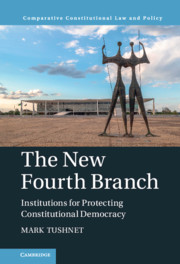Book contents
- The New Fourth Branch
- Comparative Constitutional Law and Policy
- The New Fourth Branch
- Copyright page
- Contents
- Acknowledgments
- 1 Introduction
- 2 Why a Fourth Branch?
- 3 Why a Fourth Branch?
- 4 Design Issues in General
- 5 Design Principles in Practice
- 6 Anti-corruption Investigations
- 7 Electoral Commissions
- 8 Audit Agencies
- 9 Conclusion
- Index
4 - Design Issues in General
Published online by Cambridge University Press: 20 August 2021
- The New Fourth Branch
- Comparative Constitutional Law and Policy
- The New Fourth Branch
- Copyright page
- Contents
- Acknowledgments
- 1 Introduction
- 2 Why a Fourth Branch?
- 3 Why a Fourth Branch?
- 4 Design Issues in General
- 5 Design Principles in Practice
- 6 Anti-corruption Investigations
- 7 Electoral Commissions
- 8 Audit Agencies
- 9 Conclusion
- Index
Summary
Constitution designers can identify from local and worldwide experience some general threats to constitutional democracy: conflicts over election outcomes, for example, or corruption at high and low levels.1 Their local knowledge can give them some sense of how important each type of threat might be for the systems they are designing. Variations in the types and severity of threats mean that designers must make choices: there is no one-size-fits-all “fourth branch” or any of its components. (That point should be obvious when we note the rather wide range of choices made in designing constitutional courts.)
- Type
- Chapter
- Information
- The New Fourth BranchInstitutions for Protecting Constitutional Democracy, pp. 42 - 77Publisher: Cambridge University PressPrint publication year: 2021

